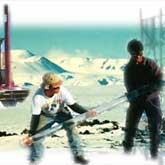How Do We Predict The Climate--100,000 Years Ago?
 Since the only ice age that occurred during human existence ended 10,000 to 12,000 years ago, how can we know today that several major ice ages occurred during earth's history? How do we know how much the temperature changed or what the carbon dioxide content of the ancient atmosphere was? Over 200 years ago, geologists began trying to explain some unusual features observed on the northern continents that we now realize were caused by glaciers. It took decades of research to establish that glaciers had left recognizable traces in the rock record and had at times during earth's past been much more widespread than they are today. During the last decade, more detailed records of climate changes have been found in cores collected from the ice caps in Greenland and Antarctica. In Greenland especially, remarkable evidence of temperature changes and even the content of earth's ancient atmosphere has been preserved in the two miles of ice that has accumulated over more than 100,000 years.
Since the only ice age that occurred during human existence ended 10,000 to 12,000 years ago, how can we know today that several major ice ages occurred during earth's history? How do we know how much the temperature changed or what the carbon dioxide content of the ancient atmosphere was? Over 200 years ago, geologists began trying to explain some unusual features observed on the northern continents that we now realize were caused by glaciers. It took decades of research to establish that glaciers had left recognizable traces in the rock record and had at times during earth's past been much more widespread than they are today. During the last decade, more detailed records of climate changes have been found in cores collected from the ice caps in Greenland and Antarctica. In Greenland especially, remarkable evidence of temperature changes and even the content of earth's ancient atmosphere has been preserved in the two miles of ice that has accumulated over more than 100,000 years.
As snow fell, air was trapped between the flakes. Near the poles, the snow never completely melted and over time was compacted into thick layers of ice. The compacted ice effectively bottled the ancient air which can now be analyzed for its carbon dioxide, methane, and other gas content. Dust trapped in the snow during dry, windy winters left dark layers. In the summer, the only time that the polar regions received sunlight, the surface snow would partially melt, then refreeze, leaving coarse, light-colored layers that contrast with the winter layers, so summer snow can be distinguished from winter snow. These layers can be counted, much like tree rings, to determine the age of a layer and to date when events occurred. Snowflakes attached to many chemicals in the air, some of which can give indications of ancient temperatures since certain chemicals tended to be present in warm air, others in cold air, and some formed only when the summer sunlight reacted with atmospheric gases.
A measure of ancient temperatures can be made in ice boreholes. Ice temperature generally increases with depth, warmed from earth's interior, but anomalous cold layers are found between warmer layers. These colder layers accumulated during ice ages and have not yet warmed to equilibrium with surrounding ice. Data from the ice are correlated with what is known from the rock record about changing climate as well as data from sea floor sediments and fossils. The chemical composition of shells of certain marine organisms can indicate if they lived in warm or cold environments. On the land, when glaciers retreated, tree rings show faster growth rates, pollen from warm climate plants was preserved in the sediments of thawed lakes. Swamps expanded, releasing more methane gas into the atmosphere. More carbon dioxide, being less soluble in warm water, was also released into the atmosphere as the planet warmed. With careful analysis, layers of ice can be read like a climate history book.
About the Author
Claire-Jean Korzenewski, BS
 Claire-Jean Korzenewski has a B.S. in geology and experience in petroleum exploration. She is an educator with public school teaching experience in junior high and high school sciences. Claire-Jean is now a freelance writer who makes communications more effective - to inform, to educate, and to enhance profits for businesses and individuals.
Claire-Jean Korzenewski has a B.S. in geology and experience in petroleum exploration. She is an educator with public school teaching experience in junior high and high school sciences. Claire-Jean is now a freelance writer who makes communications more effective - to inform, to educate, and to enhance profits for businesses and individuals.


